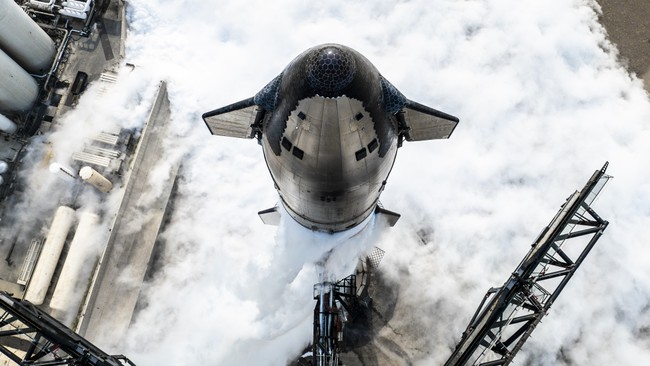
SpaceX did it again. At 6:23 p.m. local time — eight minutes late, but who’s counting? — the most powerful rocket in history lunched on a column of flame from Starbase, Texas, delivered its second stage to a hot separation, then minutes later made a perfect water landing in the Gulf of America.
Even before the Super Heavy first stage had successfully completed its part of Integrated Flight Test 11 (IFT-11), the Ship second stage’s six engines moved it to near-orbital velocity, initiating a series of flight, deployment, and engine tests before making its own water landing half a world away in the Indian Ocean.
“Starship’s eleventh flight test reached every objective, providing valuable data as we prepare the next generation of Starship and Super Heavy,” the company posted to X, one of SpaceX founder Elon Musk’s other companies.
Musk shared a stunning view of the booster’s return, along with a little context:
The rocket came back from space at hypersonic speed and then hovered at a precise position https://t.co/Bzc9rz5htj
— Elon Musk (@elonmusk) October 14, 2025
Of last night’s Super Heavy booster (known as B15-2) 33 Raptor 3 engines, 24 were “flight proven” — i.e., they were reused from previous launches. Super Heavy is rapidly achieving the rapid and inexpensive reuse necessary to make possible both the Artemis missions to Luna, and SpaceX’s missions to Mars.
The closest thing to a failure during IFT-11 was that during its reentry boostback burn, one of Super Heavy’s 13 reentry engines failed to ignite. But that’s OK. Starship uses a previously stupid number of engines so that losing one — or even a few — won’t endanger the mission.
During last night’s broadcast, a SpaceX warned that Ship’s reentry and landing might be a little rough, or even exciting — which is rocket guy-speak for “it could blow up.” That’s because of all the missing heat shield tiles, needed for any spaceship to survive the intense heat of reentering the Earth’s atmosphere.
They didn’t fall off during launch or flight or anything — SpaceX engineers strategically left off tiles from strategic, high-stress locations. Ship’s Mars flight profile requires reusability not in months (like the Space Shuttle) or in weeks (like the SpaceX Falcon 9), but in hours. Figuring out how to make that work requires pushing the Ship to the limit during these IFTs.
Yet they still didn’t manage to destroy the Ship last night. It almost seems like the SpaceX ground crew might have felt some small amount of disappointment. Cheers and backslaps all around for a shockingly smooth reentry and sticking the water landing, but since the Ship didn’t just survive — it performed to spec, even with all those missing heat shield tiles — they might also wonder: Did we test it hard enough?
Building a permanent American base on the Moon is Starship’s government side gig. Seeding a permanent human colony on Mars is the dream. In the meantime, Starship’s day job will soon involve building out and radically improving SpaceX’s Starlink global orbital internet service.
This was my perspective during Ship’s reentry last night:
“Whatchya doin?”
“Just watching a spaceship reentry with multiple 4K video streams broadcasting live through a plasma field thanks to a global satellite internet service that the rocket is designed greatly improve. You?”
— Stephen Green (@VodkaPundit) October 14, 2025
With the success of IFT-11, that’s iT for Version 2 (V2) of Super Heavy and Ship. The company has learned enough over the course of the last few missions to move on to V3 of both stages — and the improvements are nothing short of radical.
The company said in a statement last night, “This next iteration will be used for the first Starship orbital flights, operational payload missions, propellant transfer, and more as we iterate to a fully and rapidly reusable vehicle with service to Earth orbit, the Moon, Mars, and beyond.”
That’s the good news. The bad news, space fans, is all those upgrades mean that IFT-11 was almost certainly the last time we’ll see Starship fly in 2025. There’s an outside chance that IFT-12 will debut the V3 Super Heavy and Ship as soon as December, but that’s not the way to bet.
More likely, IFT-12 will take to near orbit in January or February of 2026, or even as late as March or April.
“At SpaceX, we specialize in converting things from impossible to late,” Musk once said — and that’s soon enough for me.
But only barely.
Recommended: Trump’s Middle East Moment: The Hostages Are Free, and the World Is Watching
The Schumer Shutdown is here. Rather than put the American people first, Chuck Schumer and the radical Democrats forced a government shutdown for healthcare for illegals. They own this.
Help us continue to report the truth about the Schumer Shutdown. Use promo code POTUS47 to get 74% off your VIP membership.















